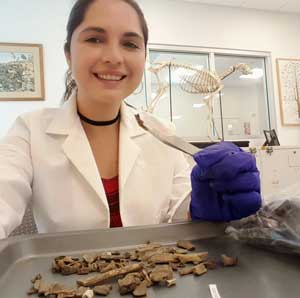Grade Level(s):
- 9-12
- College
Source:
- UC Museum of Paleontology
Resource type:
- research profile
- Science Story
Discipline:
- Life Science
Time: 20 minutes
Overview
Learn how scientists reuse and upcycle their data, while following graduate student Maria Viteri as she investigates ancient and modern small mammal communities. Get tips for using science stories in class.

- [How science works: Grades 9-12] Scientists can test ideas about events and processes long past, very distant, and not directly observable.
- [How science works: Grades 9-12] Raw data must be analyzed and interpreted before we can tell whether a scientific idea is likely to be accurate or inaccurate. (P4, P5)
- [How science works: Grades 9-12] Scientists try to be objective and work to identify and avoid bias.
- [How science works: Grades 9-12] Different scientists may interpret the same data in different ways. (P7)
- [How science works: Grades 9-12] Researchers share their findings with the scientific community through scientific publications. (P8)
- [How science works: Grades 9-12] Scientists aim for their studies to be replicable.
- [How science works: Grades 13-16] Scientists can test ideas about events and processes long past, very distant, and not directly observable.
- [How science works: Grades 13-16] Raw data must be analyzed and interpreted before we can tell whether a scientific idea is likely to be accurate or inaccurate.
- [How science works: Grades 13-16] Scientists try to be objective and work to identify and avoid bias.
- [How science works: Grades 13-16] Different scientists may interpret the same data in different ways; data interpretation can be influenced by a scientist's assumptions, biases, and background.
- [How science works: Grades 13-16] Researchers share their findings with the scientific community through scientific publications.
- [How science works: Grades 13-16] Scientists aim for their studies to be replicable.
- [The social side of science: Grades 9-12] Science depends on communication within the scientific community. (P7, P8)
- [The social side of science: Grades 9-12] Scientists scrutinize each other's work through peer review and other processes. (P7, NOS5)
- [The social side of science: Grades 9-12] Scientists are influenced by their personal experiences and cultures. (NOS7)
- [The social side of science: Grades 13-16] Science depends on communication within the scientific community.
- [The social side of science: Grades 13-16] Scientists scrutinize each other's work through peer review and other processes.
- [The social side of science: Grades 13-16] Scientists are influenced by their personal experiences and cultures.
- [Science and society: Grades 9-12] Scientific research is often focused on topics with the potential to help meet societal needs.
- [Science and society: Grades 13-16] Scientific research is often focused on topics with the potential to help meet societal needs.
- [What has science done for you lately: Grades 9-12] Scientific knowledge informs public policies and regulations that promote our health, safety, and environmental stewardship.
- [What has science done for you lately: Grades 13-16] Scientific knowledge informs public policies and regulations that promote our health, safety, and environmental stewardship.
- NOS Matrix understanding category 5. Science is a way of knowing.
- NOS Matrix understanding category 7. Science is a human endeavor.
- Science and Engineering Practice 4. Analyzing and interpreting data
- Science and Engineering Practice 5. Using mathematics and computational thinking
- Science and Engineering Practice 7. Engaging in argument from evidence
- Science and Engineering Practice 8. Obtaining, evaluating, and communicating information
There are currently no teaching tips for this resource.
